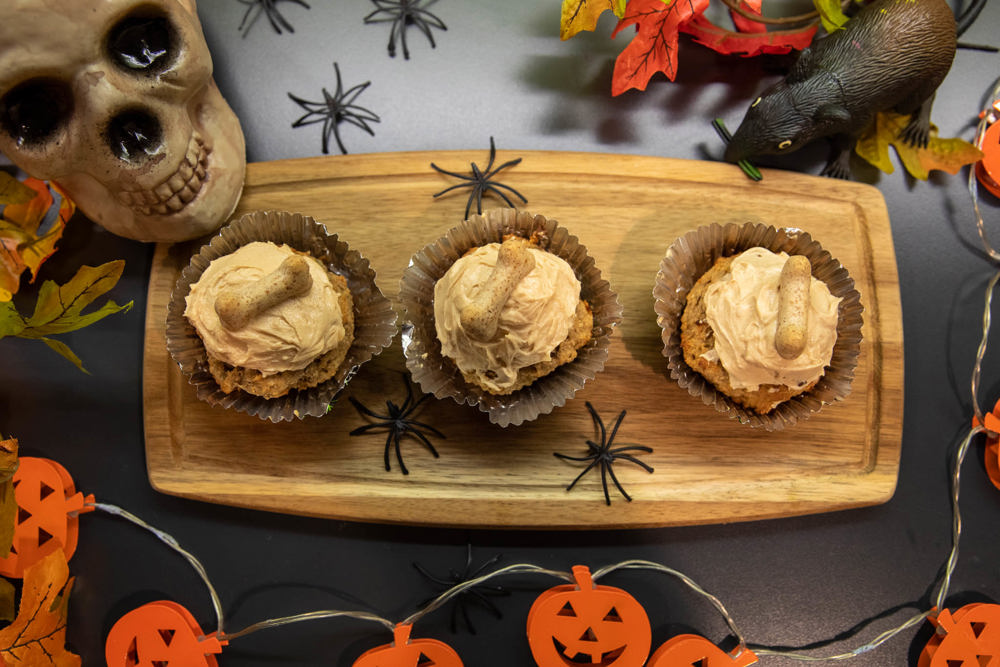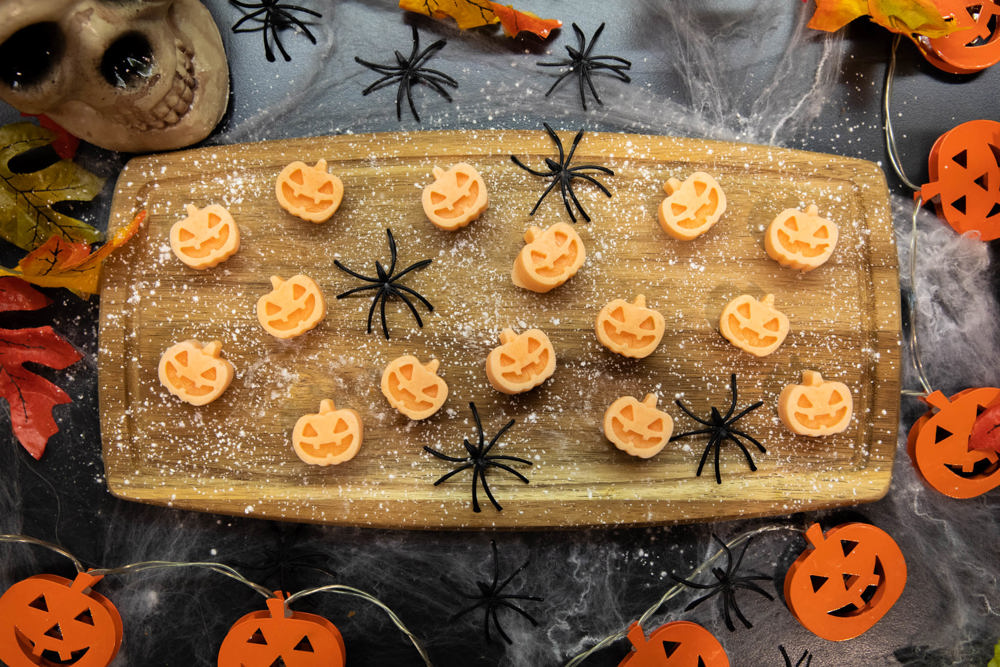If you’re thinking of celebrating Halloween then why not treat your dog to one of our spooky seasonal bakes and tasty homemade dog treats.
Our recipes
Your dog may love these delicious Halloween dog treats, but it’s important to remember to only give them occasionally as part of a well-balanced diet. Some of these recipes may not be suitable for dogs with nut allergies or other special dietary needs.
Find out more about portion control and other things to think about when treating your dog to one of our summery snacks.
Find out more about portion control and other things to think about when treating your dog to one of our summery snacks.

Happy Halloween pupcakes
Ingredients:
- 2 ripe bananas
- 2 tbsp peanut butter (xylitol-free)
- 80g honey
- 2 eggs
- 200g wholewheat flour
- 1.5 tsp baking powder
- 60ml olive oil
- 150ml water
- 50g peanut butter
- 70g Greek yoghurt (xylitol-free)
Preheat oven to 180C /160C Fan or gas mark 4
- Add all of the cupcake cases onto a cupcake tray or a large baking tray
- Using a fork, mash the bananas in a bowl until they are smooth
- Add the peanut butter, honey and eggs and mix thoroughly
- Add the flour, baking powder, olive oil and water and mix until it forms a batter
- Add the batter to your cupcake cases (spoon in until the cases are nearly full)
- Place the cupcake cases back in the cupcake tray/baking tray, and bake for 15-20 minutes, until a knife comes out clean from the centre of one of the cakes
- Leave to cool on a wire rack
- Make the topping while the pupcakes are cooling by melting the peanut butter in the microwave for 30 seconds, then in a bowl, mix the peanut butter and Greek yoghurt together, until it creates a smooth cream-coloured mixture. Top the cakes with the mixture
Ghost fancies
Ingredients:
- 150g rolled oats
- 150g wholewheat flour
- 1 egg
- 1 tbsp coconut oil
- 100g pumpkin puree
- 50g peanut butter (xylitol-free)
- 50g Greek yoghurt
- 50g Greek yoghurt
Preheat oven to 180C /160C Fan or gas mark 4
- Add a sheet of greaseproof paper to a large baking tray
- Add the oats to a blender and blitz until they resemble flour
- Add all of the ingredients to a bowl and mix thoroughly until it forms a dough
- Flour a clean surface and roll out the dough until it is one inch thick
- Using a pumpkin-shaped biscuit cutter, cut out the biscuits from the dough
- Put the biscuits onto the baking tray and bake for 15 minutes
- Leave to cool on a wire rack
- Melt the peanut butter in the microwave until it is runny
- Mix the Greek yoghurt and peanut butter in a bowl and then spoon onto a biscuit and top with a biscuit
- Then spread some Greek yoghurt onto the top biscuit and add chia seeds for eyes and a mouth
Spooky bat bites
Ingredients:
- 150g rolled oats
- 1 ripe banana
- 2 tbsp peanut butter (xylitol-free)
- 1 egg
- 2 tbsp wholewheat flour
- 50g blueberries
- 70g Greek yoghurt
Preheat oven to 180C /160C Fan or gas mark 4
- Add a sheet of greaseproof paper to a large baking tray
- Add the oats to a blender and blitz until they resemble flour
- Add the oat flour, peanut butter, banana and egg to a bowl and mix thoroughly until it forms a dough
- Flour a clean surface and roll the dough out until it is one inch thick
- Using a bat-shaped biscuit cutter, or a template, cut out the biscuits from the dough
- Add the biscuits to the baking tray and bake for 15 minutes, until golden brown
- Leave to cool on a wire rack
- Make the topping while the biscuits are cooling by adding the blueberries to a food processor, or blender, and blitzing them until they become a puree
- Add the blueberry puree to a bowl along with the Greek yoghurt and mix until it turns a purply-blue colour. Then top the biscuits with this mixture
Creepy crawly crunchies
Ingredients:
- 250g wholewheat flour
- 2 eggs
- 110g pumpkin puree
- 2 tbsp peanut butter (xylitol-free)
- 1 tsp cinnamon
Preheat oven to 180C /160C Fan or gas mark 4
- Add a sheet of greaseproof paper to a large baking tray
- Add all of the ingredients to a bowl and mix thoroughly until it forms a dough
- Knead the dough using your hands
- Flour a clean surface and roll out the dough until it is one inch thick
- Cut out your biscuits using a spider-shaped cutter, or a template
- Place the biscuits onto the baking tray and bake for 15-20 minutes
- Leave to cool down on a wire rack

Pumpkin lollies
Ingredients:
- 100g Greek yoghurt
- 50g cantaloupe melon
- 1 tbsp honey
- Remove the skin and seeds of the melon and chop into small chunks
- Add all the ingredients to a food processor and blitz until fully combined
- Add the mixture to the moulds
- Put in the freezer for a minimum of 4 hours, or overnight
- Take the treats you want to give to your dog out of the freezer a few minutes before giving them to them. This should help to make sure that they're not too hard for their teeth
Things to consider when making homemade treats for your dog
Is it safe to give my dog frozen treats?
Giving your dog ice cubes, frozen treats or putting ice in their water can be a great way to keep them cool, but is there any risk of them breaking a tooth, getting it stuck in their throat or causing them to develop life-threatening bloat?
Generally speaking, giving your dog a homemade frozen treat is ok, but there are some issues to be aware of and some precautions that we recommend you take.
All of our recipes for frozen treats contain fruit, making them softer and easier to chew than solid ice. However, to be on the safe side, and to reduce the risk of damaging teeth or causing a blockage, we recommend that you:
Generally speaking, giving your dog a homemade frozen treat is ok, but there are some issues to be aware of and some precautions that we recommend you take.
All of our recipes for frozen treats contain fruit, making them softer and easier to chew than solid ice. However, to be on the safe side, and to reduce the risk of damaging teeth or causing a blockage, we recommend that you:
- Take the treats you want to give to your dog out of the freezer a few minutes before giving to them. This should help to make sure that they're not too hard for their teeth
- Use smaller moulds to put in the freezer to make them less hard and less likely to cause a blockage if swallowed whole
Portion control
The snacks we’ve listed above should only be given as an occasional treat and must be given in moderation. Giving too much food in one go can be dangerous to dogs and could cause life threatening bloat, particularly if they’ve eaten immediately before or after exercise. Large amounts of certain foods, especially fatty foods, can also cause a painful and potentially severe condition known as pancreatitis. If you ever suspect your dog has bloat or pancreatitis, then always contact your vet immediately.
It's easy to give your dog extra food throughout the day, but doing so regularly can be damaging to their health and can make them less happy in the long run. It’s vital that you take care of what food you give to your dog. Maintaining good feeding habits will allow your dog to live the healthiest and happiest life possible.
It's easy to give your dog extra food throughout the day, but doing so regularly can be damaging to their health and can make them less happy in the long run. It’s vital that you take care of what food you give to your dog. Maintaining good feeding habits will allow your dog to live the healthiest and happiest life possible.
Counting the calories
It’s important that you divide your dog’s total calorie intake for the day between each meal so that you're not overfeeding them. If you like to give them treats, make sure that you assign a certain amount of their calories for these before working out how much to give them for each meal.
Cautions about peanut butter and xylitol
Some of the recipes above use peanut butter. Do not use these recipes if your dog has a nut allergy.
Although dogs love peanut butter, and it’s a great source of protein, you must be careful which type you use. Always avoid feeding dogs peanut butter that is high in salt and sugar and it should never contain artificial sweeteners.
Xylitol, also known as birch sugar or E967, is an artificial sweetener that is highly toxic to dogs and can cause an otherwise healthy dog's blood sugar level to drop to dangerous levels or could cause liver failure. If your dog ever eats xylitol then contact your vet immediately.
Although dogs love peanut butter, and it’s a great source of protein, you must be careful which type you use. Always avoid feeding dogs peanut butter that is high in salt and sugar and it should never contain artificial sweeteners.
Xylitol, also known as birch sugar or E967, is an artificial sweetener that is highly toxic to dogs and can cause an otherwise healthy dog's blood sugar level to drop to dangerous levels or could cause liver failure. If your dog ever eats xylitol then contact your vet immediately.
Suitability
These recipes may not be suitable for all dogs, particularly those on a special diet or those that suffer from obesity, pancreatitis, diabetes, a sensitive stomach or those with problems with their kidneys or liver. If your dog has any pre-existing health conditions then always talk to your vet about any special diets that they may need, or what treats you can give them.
